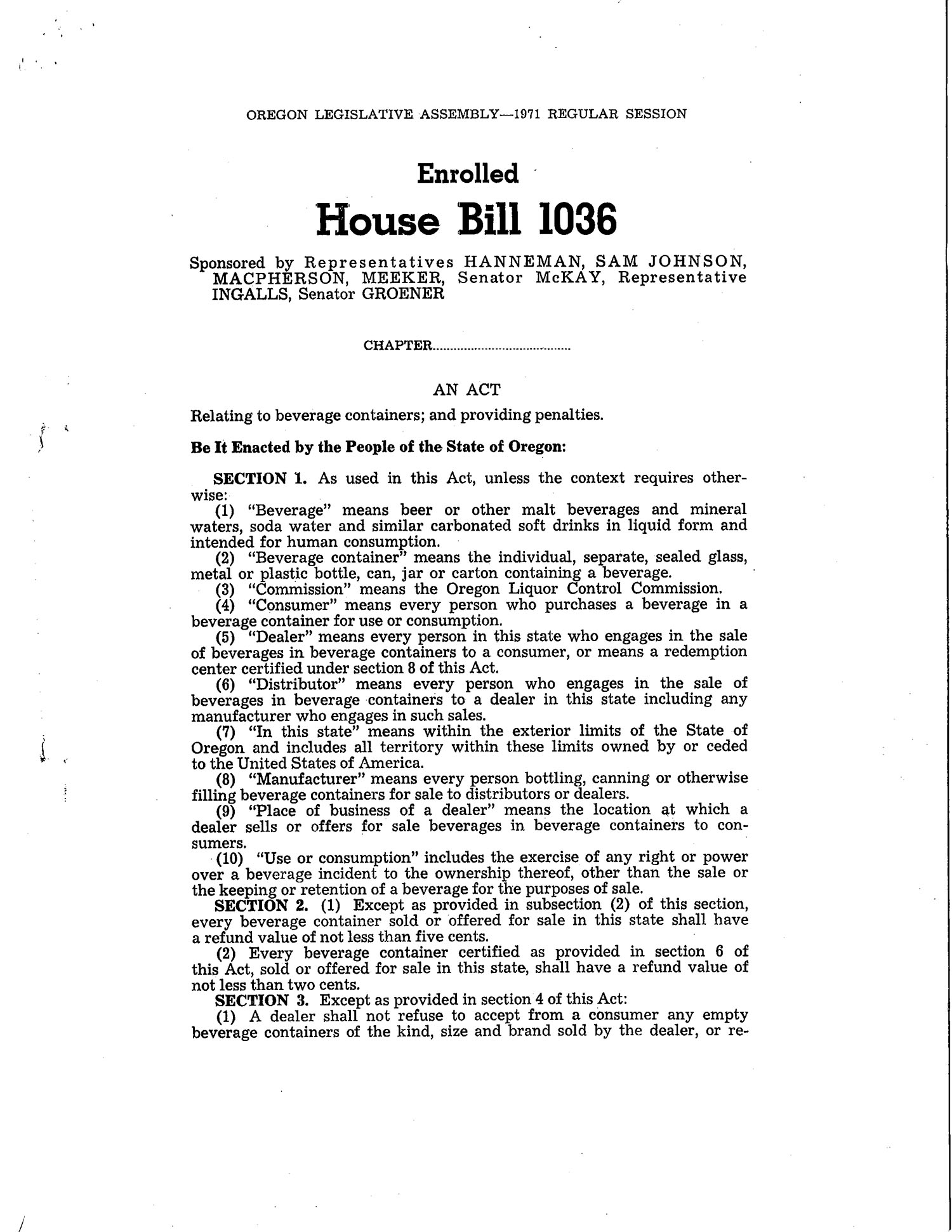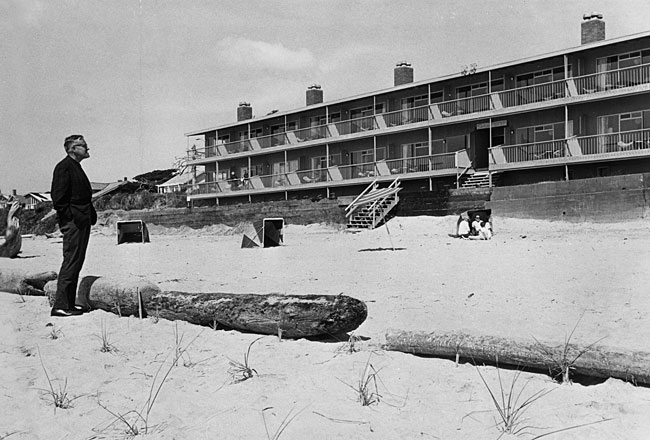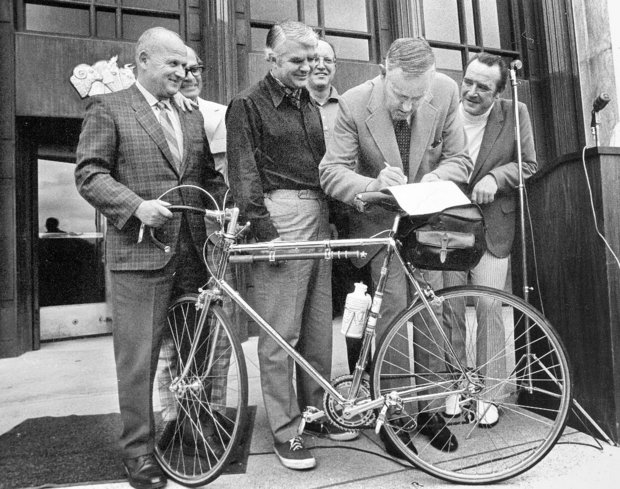The Oregon Beverage Container Act of 1971, popularly called the Bottle Bill, remains one of the most visible and popular legacies of Oregon’s environmentalism in the 1960s and 1970s. The Bottle Bill exemplifies the broad environmental activism of the time and Governor Tom McCall’s style of leadership. It also has an important continuing policy legacy in Oregon and across the nation.
Although Governor Tom McCall often receives credit for the bill, his biographer Brent Walth asserts that Richard Chambers is its “true father.” The litter he encountered when hiking disgusted Chambers; and when he read in 1968 that British Columbia had initiated a deposit system to reduce litter, he contacted his state representative, Republican Paul Hanneman.
Hanneman agreed to sponsor a container deposit bill in the 1969 legislative session, and Chambers methodically and creatively promoted and built support for the bill. The 1969 bill received more support than originally anticipated, but it was ultimately defeated because of lobbying by the aluminum and bottling industries and their associated unions. Although Hanneman had initially obtained McCall’s support for the bill, the governor contributed to the defeat by writing a letter stating that the time was not right for this bill.
Even before the 1971 session opened, McCall made the revised bottle bill his own, declaring in 1970: “I want to make it very clear that there will be no quid pro quo in the form of relaxation of my commitment to put a price on the head of every beer can and pop bottle in the United States." The bill faced fierce opposition from national groups representing the bottling and aluminum industry and associated unions who feared the practice could spread across the country.
The bill passed in 1971 because of Chambers’s continuing dedication, McCall’s high-profile commitment, broad public activism by civic groups, and political errors by the bill’s opponents. As the measure advanced, opposing lobbyists, many from outside Oregon, put pressure on supporters. The bill’s passage was assured when these efforts, which included thinly veiled bribery, became public.
Senator Betty Roberts, chair of the Senate Consumer Affairs Committee handling the bill, is quoted in Walth's biography as having received an anonymous call promising "plenty of money for Democratic candidates" if the bill was killed. The overwhelming passage of the bill in the Republican-controlled House (54-6) and the Democratic Senate (22-8) and Governor McCall’s leadership demonstrate the bipartisanship of that era.
The contemporary bottle deposit system put in place by the bill differs from the older practice of cleaning and reusing the same containers. As glass and aluminum containers became less expensive, the change to “no deposit/no return” after World War II freed the largest brewers from having to collect used containers. The Bottle Bill system in Oregon was created to control litter. In practice, the system promotes recycling, not reusing, and the collected containers are generally destroyed and made into new containers.
Oregon has made significant amendments to the 1971 law two times, with the sponsorship of Representative Vicki Berger, Richard Chambers’s daughter. In 2009, a nickel deposit was placed on all noncarbonated water bottles. Two years later, in June 2011, the law was expanded to cover all beverages except wine, liquor, milk, and milk substitutes by 2018. The 2011 law allows the deposit price to become 10 cents per container if redemption rates fall below 80 percent for two years in a row and promotes regional collection centers.
In 2013, a pilot program was approved to establish a redemption center in Salem that would serve as the container collection center for participating retailers located within two miles of the center. "Participating retailers" are those who share their deposit revenues with the redemption centers. Supportive retailers, located two to three and a half miles of the centers, also benefit from having to accept only 24 containters per customer at a time, rather than the 144 general statewide limit. The redemption centers accept up to 350 containers per cutsomer. The pilot project was considered a success and, as of June 2014, seven operate in Oregon.
Over time, the regional recycling centers are intended to replace most of container return systems in stores. Although the Oregon Liquor Control Commission (OLCC) has oversight authority for implementing the bottle laws, the process is largely handled in the private sector, with merchants cooperating to recycle containers through the Oregon Beverage Recycling Cooperative (OBRC). The actual deposit money goes from the consumer to the merchant to the OBRC and then back through the cycle to the consumer, with the OLCC entirely outside the financial loop.
The Bottle Bill instantly reduced litter in Oregon. The share of beverage containers in roadside litter in the state declined from 40 percent before the law was passed to 10.8 percent in 1973 and 6 percent in 1979. The Bottle Bill also reenforces the practice of recycling. In the 2000s, about 84 percent of beverage containers were recycled, helping to make Oregon fourth in the nation for its rate of recycling.
Since 1971, ten states have adopted bottle bills, including Michigan, where the basic deposit is 10 cents, and Maine, where the bill covers all beverages except milk and unprocessed cider.
-
![]()
House Bill 1036, 1971.
Courtesy Oregon State Archives
-
![]()
Gov. Tom McCall and Mrs. Joe Rand at a YWCA pro-recycling event in Portland, 1970.
Courtesy Oreg. Hist. Soc. Research Lib., cn012697
Related Entries
-
![Oregon Beach Bill]()
Oregon Beach Bill
Oregonians struggling to maintain public access to Pacific Ocean beache…
-
![Oregon Bicycle Bill]()
Oregon Bicycle Bill
On June 11, 1971, Governor Tom McCall, with his usual flair for publici…
-
![Thomas William Lawson McCall (1913-1983)]()
Thomas William Lawson McCall (1913-1983)
Tom McCall, more than any leader of his era, shaped the identity of mod…
Related Historical Records
Map This on the Oregon History WayFinder
The Oregon History Wayfinder is an interactive map that identifies significant places, people, and events in Oregon history.
Further Reading
Walth, Brent. Fire at Eden's Gate. Portland: Oregon Historical Society, 1998.
Walth, Brent. “No Deposit, No Return: Richard Chambers, Tom McCall, and the Oregon Bottle Bill.” Oregon Historical Quarterly 95 (1994): 278-99.





